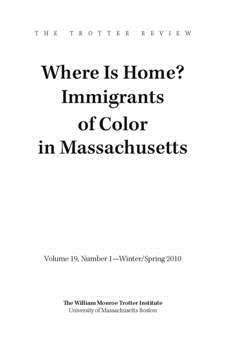Volume 19, Issue 1 (2010) Where is Home? Immigrants of Color in Massachusetts
It’s an explanation often heard around Boston. Why hasn’t the city ever elected a black mayor? Because the black community is “too small.” Why can’t the community sustain an FM radio station? And why does it have difficulty keeping afloat a weekly newspaper, even a soul food restaurant? Again, the answer comes: the community is too small. The irreconcilable flaw of this line of reasoning is exposed when it is expanded to the whole country. Black mayors have been elected in any number of cities with smaller black populations, proportionally, than the 25 percent in Boston—Los Angeles, San Francisco, and Denver, to name but three. Black-owned media and soul food restaurants manage to survive in those cities too.
Boston’s black community, functionally, feels smaller than it is because it is so divided, into the old-line black Brahmins, the relative newcomers from the South, and the immigrants from the islands of the Caribbean, from Cape Verde and the rest of Africa. Except for mainland African immigrants, the presence of these groups is not new in the Commonwealth. As far back as the 1880s, West Indians who lived in Boston had the heft to publish a weekly newspaper, one, by the way, designed to appeal to a general black audience. The Cape Verdean population predates, by a century, the influx of southerners during the Great Migration.
Just a few decades ago, black Boston residents born in America and those with immigrant origins worked together to cast off systematic segregation in city schools and wanton discrimination in workplaces. A large number of community leaders from that older generation have Caribbean roots—Mel King, Michael Haynes, and Ken Guscott as well as the late Elma Lewis, Ruth Batson, and John Bynoe. John Cruz, father and son, have Cape Verdean ancestry. Those descendants of immigrants found common cause with their native-born peers, Otto and Muriel Snowden, Tom Atkins, Paul Parks, John O’Bryant, Jean McGuire, and Ed Brooke. Though not everybody got along just fine all the time, both groups, and that was not how they were aligned, collaborated to achieve shared goals. So what happened to the unity? Has it dissipated because in-your-face racism no longer presses down on everyone black? It’s a facile answer, one that falsely assumes that the only sources of unity come from outside the community.
From the issue Commentary by Kenneth J. Cooper.
Front Matter
Articles
Introduction
Barbara Lewis Ph.D.
Working Across Difference to Build Urban Community, Democracy, and Immigrant Integration
Timothy Sieber and Maria Centeio
Diasporic Cultural Citizenship: Negotiate and Create Places and Identities in Their Refugee Migration and Deportation Experiences
Shirley S. Tang
Immigration, Ethnicity, and Marginalization: The Maya K’iche of New Bedford
Jorge Capetillo-Ponce and Gissell Abreu-Rodriguez
Service versus Advocacy? A Comparison of Two Latino Community-Based Organizations in Chelsea, Massachusetts
Glenn Jacobs
Forgotten Migrations from the United States to Hispaniola
Ryan Mann-Hamilton
Commentary
Kenneth J. Cooper
Back Matter

Editors
- Editor
- Kenneth J. Cooper
- Director, Trotter Institute
- Barbara Lewis


